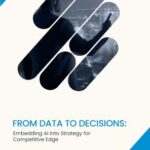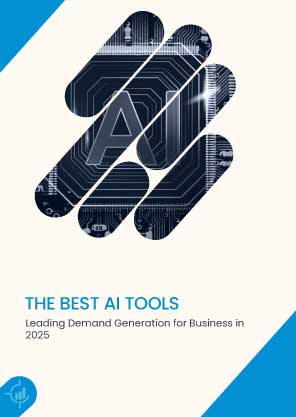or call: +1 (845) 347-8894

or call: +1 (845) 347-8894

Most companies fritter away their marketing spend pursuing leads that would never actually convert. It’s a hard truth, but in 2025, using old demand generation methods is equivalent to throwing darts in the dark and expecting something to stick. The game has changed. Today, it’s not about how much you spend, but how smartly you use your data, your timing, and your tools.
That’s where AI steps in, not as a trendy add-on, but as the central force powering precision, personalization, and performance in demand generation. From predicting buyer intent to automating conversations, AI tools are becoming the lead actors in a story where speed, accuracy, and relevance decide who wins and who fades out.
In this article, we examine the AI platforms that are redefining the playbook for today’s businesses and enabling them to find and convert their best customers quicker than ever.
Remember the last time you attempted to connect with a prospective customer? Did you take an educated guess at what they needed? Send a message and pray they respond. That’s a money and time drain. AI shifts by utilizing actual data to know customer behavior and intent. It enables companies to cut through the noise and concentrate on individuals who are willing to buy.
By 2025, buyer journeys will be more intricate. Individuals study solutions on websites, social media, and messaging platforms. AI monitors indicators from all these touchpoints and assists marketers in reaching customers when they’re most receptive to conversations. The outcome? More qualified leads, quicker sales, and wiser use of resources.
AI is powering many parts of demand generation, from spotting interested buyers early to personalizing every interaction. Here are some of the best AI tools that businesses trust in 2025:
HubSpot AI tools enable companies to pay attention to the most important leads. It examines the way individuals engage with your site and emails, then prioritizes leads based on their likelihood to make a purchase. This results in salespeople investing time on prospects who are actually interested, not on contacts at random. It also alters messages automatically depending on what every visitor does. So, for example, if someone is spending time on pricing pages, they’re getting different emails than someone reading a blog post. This level of personalization generates higher responses.
HubSpot reports that companies using its marketing automation tools see an average of 451 percent increase in qualified leads over time. This is based on aggregate performance data shared in their official customer stories and benchmarks.
Drift lets you talk to website visitors in real-time using AI chatbots. Instead of waiting for a visitor to fill out a form or send an email, Drift’s bot starts a conversation instantly. It asks questions, answers simple queries, and even schedules meetings with sales reps all automatically. Because responses come right away, visitors feel heard and valued. That keeps them engaged longer and moves them down the sales funnel faster.
According to Drift, companies using its platform experience up to 70 percent faster lead response times and a 10 to 20 percent increase in sales meetings booked. These results are cited from user reports in Drift’s public success stories.
Mutiny helps you turn anonymous website traffic into engaged visitors by showing them personalized headlines, calls to action, and landing pages based on their industry, company size, or past behavior. It’s made for B2B companies that want to convert traffic into a pipeline without needing a developer to update the site every time.
Mutiny users have reported up to 60 percent higher conversion rates on personalized landing pages, as shared in their public customer stories. It integrates well with tools like Salesforce and Marketo, making it easy to bring personalization into your existing stack.
Marketo’s AI capabilities ensure your messages are reaching the right audience at the right moment. It gets to know what type of content each lead is interested in and delivers emails or ads that align with their interests and stage of purchase. This type of attention accomplishes trust development and gets leads closer to making a purchase. The platform also tracks how leads respond, helping marketers adjust their strategies quickly.
Marketo’s official reports indicate that more than a 20 percent improvement in campaign conversion rates is achieved by users through AI workflows and behavior-driven automation. These statistics are emphasized in Adobe’s enterprise marketing reports and customer case studies.
Conversica offers AI staff that follow up with leads. They contact you through text or email, make inquiries to know the needs of the lead, and schedule meetings when a person is willing to speak with a salesperson. This ensures no lead falls through the cracks or is neglected. As the AI is doing the mundane outreach, the sales team can close more deals.
Conversica says businesses deploying its solution experience up to a 50 percent increase compared to standard outreach alone. These numbers are corroborated by case studies posted on Conversica’s website.
Salesforce Einstein brings AI directly into your CRM. It studies customer data and suggests which leads are worth chasing, what to say next, and how likely deals are to close. It also automates repetitive tasks like entering data or prioritizing emails. This helps sales and marketing work smarter and faster without adding more people.
Based on Salesforce, Einstein AI users gain a 35 percent boost in productivity and up to 25 percent shorter sales cycles, according to data presented through Salesforce’s yearly “State of Sales” reports and customer feedback.
Startups gain from AI applications through the automation of processes such as lead scoring, follow-up, and data analysis. With few sales and marketing units, AI assists in prioritizing high-value leads and simplifying workflow. Tools like Drift and HubSpot are popular for their ease of use and quick setup.
Businesses need AI tools that can manage complicated data landscapes and unify across platforms. They tend to utilize technologies such as Salesforce Einstein for sophisticated account-based marketing, predictive analytics, and cross-channel orchestration. These platforms can support large teams and enable granular insights for aligning sales and marketing.
Using AI doesn’t mean turning everything over to machines. It means making smarter choices with the tools at your side. Here’s how to make use of them:
AI in demand generation is still just getting started. Soon, tools will be able to adjust messaging across channels in real-time, predict customer behavior even more accurately, and support marketing in ways we haven’t seen yet. But one thing won’t change: people buy from businesses they trust. AI helps you build that trust by showing up in the right way, at the right time, with something that feels personal, not robotic.
AI-powered demand generation uses artificial intelligence to automate and improve how businesses attract and convert potential buyers. It helps with lead scoring, personalized content, predictive targeting, and better timing, so marketing and sales teams can focus on qualified prospects.
In 2025, buyers expect personalized, timely engagement. AI tools analyze behavior data to predict intent and automate outreach, making it easier to deliver the right message at the right time. This leads to more efficient lead generation, faster response times, and better ROI.
Start by identifying your pain points. If you’re struggling with follow-ups, look at tools like Conversica. For personalization, consider Mutiny. If you need all-in-one marketing automation, HubSpot or Marketo are great options. Always test a tool with a specific goal before scaling it.
Not necessarily. Most modern AI tools are built with non-technical users in mind. They offer intuitive dashboards, templates, and integrations. Still, having someone on your team who understands data and workflows will help you get the most out of them.
Yes. Many tools offer tiered pricing, with entry-level plans suited for startups or small teams. You don’t need a massive budget to get started. Focus on one tool that solves a key challenge, then scale up as your pipeline grows.
To participate in our interviews, please write to our IntentTech Media Room at sudipto@intentamplify.com




